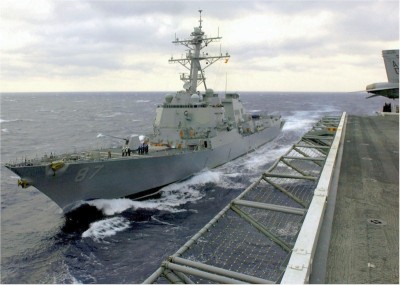
A new automated chemical warfare agent detection capability that successfully passed operational tests aboard guided-missile destroyer USS Mason (DDG 87) will be installed on warships throughout the Fleet. The Navy plans to install the new system - designed to quickly alert warfighters to the presence of chemical warfare agents - on all active guided missile destroyers and cruisers, aircraft carriers, large and small deck amphibious ships, littoral combat ships and dry cargo/ammunition ships by the end of 2018. "I am excited to have the Improved Point Detection System - Lifecycle Replacement on board," said USS Mason Commanding Officer Cmdr. Adan Cruz. "As Captain, I hold the responsibility for the safety of the crew and this system provides enhanced chemical warfare defense to ensure our sailors will return home safely." The USS Mason is pictured in 2006 approaching the Nimitz-class aircraft carrier USS Dwight D. Eisenhower (CVN 69) for a replenishment at sea. (U.S. Navy photo by Photographer's Mate 3rd Christopher B. Long)
NORFOLK and DAHLGREN, Va. (Feb. 15, 2012)—A new automated chemical warfare agent detection capability that successfully passed operational tests aboard USS Mason (DDG 87) will be installed on warships throughout the Fleet, Navy officials announced Feb. 15.
The Navy plans to install the new system - designed to quickly alert warfighters to the presence of chemical warfare agents - on all active guided missile destroyers and cruisers, aircraft carriers, large and small deck amphibious ships, littoral combat ships and dry cargo/ammunition ships by the end of 2018.
"IPDS-LR (Improved Point Detection System - Lifecycle Replacement) will provide the Navy continued chemical warfare agent detection, identification and alerting along with the high system reliability they need to perform their mission worldwide," said Bruce Corso, IPDS-LR System Manager, office of the Joint Project Manager for Nuclear, Biological and Chemical Contamination Avoidance (JPM NBCCA).
"This successful deployment of the IPDS-LR is a culmination of the work of some great scientists and engineers, collaboration with the Joint Community, and having waterfront locations that provide continuous fleet interaction," said Naval Surface Warfare Center Dahlgren Division (NSWCDD) Chemical, Biological and Radiological (CBR) Defense Division Head Mike Purello.
Warfighters aboard USS Mason - the first guided missile destroyer (DDG) protected by IPDS-LR - are now relying on a better performing system that features ion mobility spectrometry. This chemical detection technology creates ions that separate by the time it takes the ion clusters to traverse a constant electric field drift region.
"I am excited to have the Improved Point Detection System - Lifecycle Replacement on board," said USS Mason Commanding Officer Cmdr. Adan Cruz after testing concluded Jan. 27. "As Captain, I hold the responsibility for the safety of the crew and this system provides enhanced chemical warfare defense to ensure our sailors will return home safely."
"The install went extremely well," said USS Mason Executive Officer Cmdr. Mike Briggs. "Having a reliable chemical detection system onboard to aid in ship's defense goes towards making Mason a more effective warship."
Teams based in Norfolk, Va., and San Diego, Calif., are prepared to install the new system on 35 ships in 2012.
USS William P. Lawrence (DDG-110), USS Howard (DDG-83) and USS Mesa Verde (LPD-19) are the next ships on NSWCDD CBR Defense Division's schedule for IPDS-LR installation.
"More DDGs will follow," said NSWCDD IPDS-LR Project Lead Brian Flaherty. "The sailor will see a system they can turn on and be confident it is protecting them. It samples air from outside the ship, evaluates it for the presence of chemical warfare agents and if there's an agent present - IPDS-LR will alert them in an adequate amount of time to take precautionary measures."
IPDS-LR components located on the port and starboard sides of a ship sample air through external intakes in the hull. The system analyzes the external air for chemical agents.
"If the detector identifies a chemical agent, it sends a signal that displays an alert at both the ship's damage control central and the bridge," said Flaherty. "The system also interfaces directly to the ship's chemical alarm, which broadcasts an audible ship-wide alarm to alert the crew of a chemical warfare agent."
IPDS-LR's test and Evaluation involved extensive time both in the laboratory and aboard ship - with extensive time at sea as well as an independent underway evaluation by the Navy's Commander Operational Test and Evaluation Force.
"The new system is more maintainable and reliable," said Flaherty. "Warfighters will see improved false alarm performance and longer periods of time between repairs. It will be easier and cheaper to repair."
Based on a commercial-off-the-shelf concept, a joint team of NSWCDD and JPM NBCCA engineers evaluated IPDS-LR in reliability, availability, and maintainability (RAM) tests emphasizing a Navy shipboard maritime environment.
The team collected over 14,000 hours of underway and in-port test time supporting the RAM analysis with multiple ships - and ship classes - based in the Norfolk and San Diego areas. Additional data collection continued aboard ships in forward deployed locations.
"It's very rewarding to field this system to the Fleet," said Flaherty, noting that his team conducted "IPDS-LR tests on the Navy side - shock testing, vibration testing, electromagnetic interference - and worked with different groups over two-and-a-half years to make sure the system is ready to field to the warfighter."
"The Navy's CBR Defense Division exists to provide our warfighter with the tools and capabilities necessary to detect, protect, and if necessary, decontaminate threats resulting from a CBR attack," said Purello. "Our direct and active connection with the Fleet helps the warfighter and provides a wealth of valuable information for our scientists and engineers in the lab. This knowledge is immediately put to use as they work to create, develop, and provide updates and future solutions for our men and women in uniform."
A Navy leader in CBR Defense, NSWC Dahlgren's CBR Defense Division provides a full complement of capabilities that support the naval warfighter both on land and at sea as well as the joint and Homeland Defense communities.

